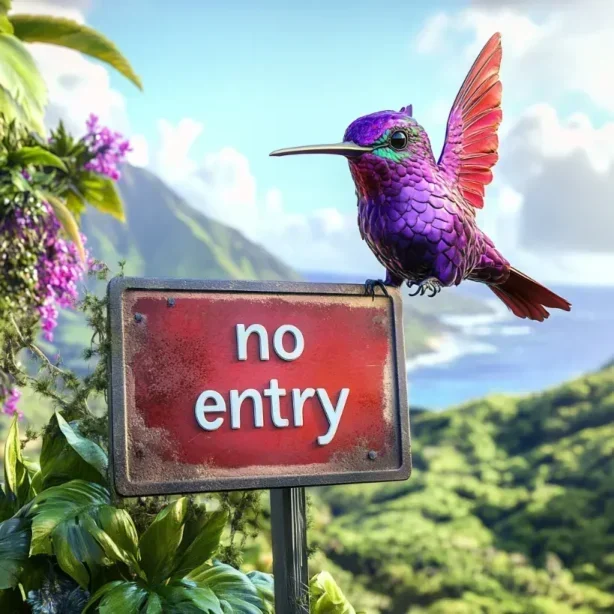(Or: How Geography and Evolution Created a Hummingbird-Free Paradise)
While Hawaii’s lush tropical landscapes might seem like a perfect paradise for hummingbirds, these remarkable aerial acrobats are conspicuously absent from the island chain. The story behind this absence reveals fascinating insights into biogeography, evolution, and the unique development of island ecosystems.
The Geographic Challenge
Picture trying to fly from California to Hawaii. Now imagine doing it while weighing less than a penny. This gives you an idea of the primary reason they never made it to Hawaii – the vast Pacific Ocean presents an insurmountable barrier for these tiny travellers.
Key geographic factors include:
- 2,400 miles of open ocean
- No island stepping stones
- Lack of food sources along the way
Even the most accomplished long-distance flying hummingbird species, which can cross the Gulf of Mexico in a single flight, would find the Pacific crossing impossible. The distance is simply too great for their small bodies and high-energy needs.
The Evolutionary Tale
Nature, however, abhors a vacuum. While hummingbirds never reached Hawaii, the islands developed their own remarkable suite of nectar-feeding birds through a process called convergent evolution.
The Hawaiian honeycreepers, descended from finch-like ancestors, evolved to fill many of the same niches that hummingbirds occupy in the Americas:
- Long, curved beaks for nectar feeding
- Specialized tongues for nectar extraction
- Ability to hover (though less efficiently than hummingbirds, relying mostly on perching)
The Pollination Partners
Hawaiian plants never waited for hummingbirds to arrive. Instead, they developed complex relationships with local pollinators that were already present on the islands:
- Native Hawaiian honey eaters
- Endemic bee species
- Specialized moths and butterflies
These relationships have become so intricate and specific that introducing hummingbirds now could potentially disrupt these finely tuned ecological partnerships.
The Introduction Question
Some might wonder why humans haven’t simply introduced these tiny beauties to Hawaii. The reality is that it’s illegal to import hummingbirds (or any non-native birds) into Hawaii under state law. This prohibition is part of Hawaii’s strict quarantine and importation regulations designed to protect the islands’ unique ecosystems. The reasons for this legal protection are both practical and ecological:
- Potential disruption of native ecosystems
- Competition with endemic species
- Risk to unique Hawaiian flora
- Protection of native pollinator relationships
- Prevention of new disease introduction
Hawaii’s importation laws (Hawaii Administrative Rules, Title 4, Subtitle 6, Chapter 71) specifically restrict the introduction of non-native birds, including hummingbirds, to protect:
- Endemic Hawaiian bird species
- Native plant-pollinator relationships
- Overall ecosystem balance
- Agricultural interests
These legal protections, combined with natural barriers, ensure that Hawaii will remain hummingbird-free, preserving its unique ecological relationships that have evolved over millions of years.
The Island Adaptation Story
Hawaii’s isolation has led to the evolution of unique adaptations among its native nectar-feeding birds that differ from hummingbird solutions:
- Different hovering techniques
- Alternative feeding strategies
- Unique beak shapes
- Varied ecological roles
The Conservation Connection
The absence of these vibrant wonders in Hawaii helps protect the islands’ unique native species. Many of Hawaii’s endemic birds are already endangered, and introducing a new competitor could further threaten their survival.
The Future Perspective
Climate change and human activity continue to reshape Hawaii’s ecosystems, but hummingbirds are unlikely to ever become established there naturally. The Pacific Ocean remains an effective barrier, and conservation laws protect against introduction.
Conclusion: An Evolutionary Experiment
The absence of hummingbirds in Hawaii demonstrates how isolation shapes evolution and how nature finds different solutions to similar challenges. While these tiny aerial acrobats may never dance among Hawaii’s tropical flowers, the islands have their own unique and beautiful nectar-feeding birds.
Remember: When you visit Hawaii, take time to appreciate its native nectar-feeding birds. They may not be hummingbirds, but they represent an equally remarkable story of evolutionary adaptation.
Some biologists suspect that if these beautiful creatures had reached Hawaii, they might have evolved into even more spectacular forms. While the birds maintain their continental preferences, the unique pressures of island evolution could have created some truly remarkable species.


